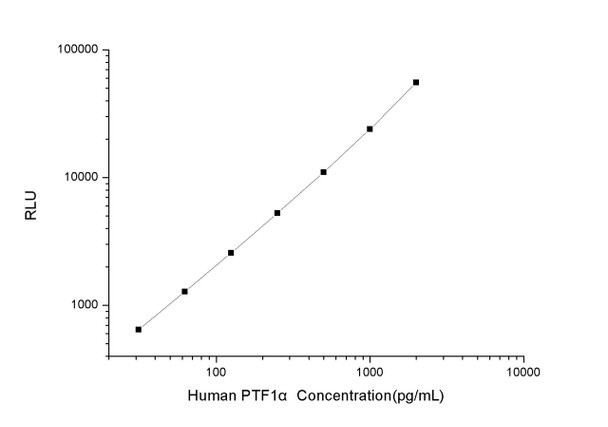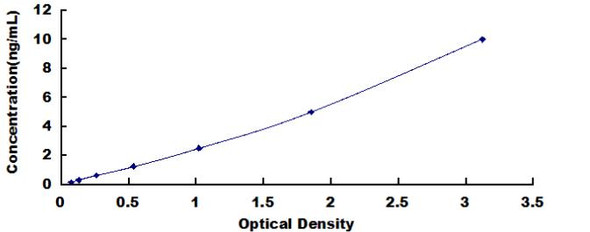Human Developmental Biology ELISA Kits
Human PTF1 alpha (Pancreas Specific Transcription Factor 1 alpha) CLIA Kit (HUES01173)
- SKU:
- HUES01173
- Product Type:
- ELISA Kit
- ELISA Type:
- CLIA Kit
- Size:
- 96 Assays
- Sensitivity:
- 18.75pg/mL
- Range:
- 31.25-2000pg/mL
- ELISA Type:
- Sandwich
- Reactivity:
- Human
- Sample Type:
- Serum, plasma and other biological fluids
- Research Area:
- Developmental Biology
Description
| Assay type: | Sandwich |
| Format: | 96T |
| Assay time: | 4.5h |
| Reactivity: | Human |
| Detection method: | Chemiluminescence |
| Detection range: | 31.25-2000 pg/mL |
| Sensitivity: | 18.75 pg/mL |
| Sample volume: | 100µL |
| Sample type: | Serum, plasma and other biological fluids |
| Repeatability: | CV < 15% |
| Specificity: | This kit recognizes Human PTF1 alpha in samples. No significant cross-reactivity or interference between Human PTF1 alpha and analogues was observed. |
This kit uses Sandwich-CLIA as the method. The micro CLIA plate provided in this kit has been pre-coated with an antibody specific to Human PTF1 alpha. Standards or samples are added to the appropriate micro CLIA plate wells and combined with the specific antibody. Then a biotinylated detection antibody specific for Human PTF1 alpha and Avidin-Horseradish Peroxidase (HRP) conjugate are added to each micro plate well successively and incubated. Free components are washed away. The substrate solution is added to each well. Only those wells that contain Human PTF1 alpha, biotinylated detection antibody and Avidin-HRP conjugate will appear fluorescence. The Relative light unit (RLU) value is measured spectrophotometrically by the Chemiluminescence immunoassay analyzer. The RLU value is positively associated with the concentration of Human PTF1 alpha. The concentration of Human PTF1 alpha in the samples can be calculated by comparing the RLU of the samples to the standard curve.
| UniProt Protein Function: | PTF1A: Transcriptional activator. Binds to the E-box consensus sequence 5'-CANNTG-3'. Plays an important role in determining whether cells allocated to the pancreatic buds continue towards pancreatic organogenesis or revert back to duodenal fates. May be involved in the maintenance of exocrine pancreas-specific gene expression including ELA1 and amylase. Required for the formation of pancreatic acinar and ductal cells. Plays an important role in cerebellar development. Defects in PTF1A are the cause of diabetes mellitus and cerebellar hypoplasia/agenesis (DMCH). |
| UniProt Protein Details: | Chromosomal Location of Human Ortholog: 10p12. 2 Cellular Component: cytoplasm; nucleus; transcription factor complex Molecular Function:DNA binding Biological Process: cerebellum development; exocrine pancreas development; pancreas development; regulation of transcription, DNA-dependent; tissue development Disease: Pancreatic Agenesis 2; Pancreatic And Cerebellar Agenesis |
| NCBI Summary: | This gene encodes a protein that is a component of the pancreas transcription factor 1 complex (PTF1) and is known to have a role in mammalian pancreatic development. The protein plays a role in determining whether cells allocated to the pancreatic buds continue towards pancreatic organogenesis or revert back to duodenal fates. The protein is thought to be involved in the maintenance of exocrine pancreas-specific gene expression including elastase 1 and amylase. Mutations in this gene cause cerebellar agenesis and loss of expression is seen in ductal type pancreas cancers. [provided by RefSeq, Jul 2008] |
| UniProt Code: | Q7RTS3 |
| NCBI GenInfo Identifier: | 74749931 |
| NCBI Gene ID: | 256297 |
| NCBI Accession: | Q7RTS3. 1 |
| UniProt Secondary Accession: | Q7RTS3,Q9HC25, |
| UniProt Related Accession: | Q7RTS3 |
| Molecular Weight: | 34,970 Da |
| NCBI Full Name: | Pancreas transcription factor 1 subunit alpha |
| NCBI Synonym Full Names: | pancreas specific transcription factor, 1a |
| NCBI Official Symbol: | PTF1A |
| NCBI Official Synonym Symbols: | PACA; PAGEN2; bHLHa29; PTF1-p48 |
| NCBI Protein Information: | pancreas transcription factor 1 subunit alpha |
| UniProt Protein Name: | Pancreas transcription factor 1 subunit alpha |
| UniProt Synonym Protein Names: | Class A basic helix-loop-helix protein 29; bHLHa29; Pancreas-specific transcription factor 1a; bHLH transcription factor p48; p48 DNA-binding subunit of transcription factor PTF1; PTF1-p48 |
| Protein Family: | Pancreas transcription factor |
| UniProt Gene Name: | PTF1A |
| UniProt Entry Name: | PTF1A_HUMAN |
As the RLU values of the standard curve may vary according to the conditions of the actual assay performance (e. g. operator, pipetting technique, washing technique or temperature effects), the operator should establish a standard curve for each test. Typical standard curve and data is provided below for reference only.
| Concentration (pg/mL) | RLU | Average | Corrected |
| 2000 | 55353 56089 | 55721 | 55693 |
| 1000 | 22410 25538 | 23974 | 23946 |
| 500 | 11985 10079 | 11032 | 11004 |
| 250 | 5057 5531 | 5294 | 5266 |
| 125 | 2679 2537 | 2608 | 2580 |
| 62.5 | 1380 1242 | 1311 | 1283 |
| 31.25 | 628 720 | 674 | 646 |
| 0 | 27 29 | 28 | -- |
Precision
Intra-assay Precision (Precision within an assay): 3 samples with low, mid range and high level Human PTF1 alpha were tested 20 times on one plate, respectively.
Inter-assay Precision (Precision between assays): 3 samples with low, mid range and high level Human PTF1 alpha were tested on 3 different plates, 20 replicates in each plate.
| Intra-assay Precision | Inter-assay Precision | |||||
| Sample | 1 | 2 | 3 | 1 | 2 | 3 |
| n | 20 | 20 | 20 | 20 | 20 | 20 |
| Mean (pg/mL) | 108.88 | 275.43 | 987.00 | 98.76 | 274.35 | 1044.15 |
| Standard deviation | 8.84 | 32.09 | 104.03 | 8.71 | 21.87 | 109.22 |
| C V (%) | 8.12 | 11.65 | 10.54 | 8.82 | 7.97 | 10.46 |
Recovery
The recovery of Human PTF1 alpha spiked at three different levels in samples throughout the range of the assay was evaluated in various matrices.
| Sample Type | Range (%) | Average Recovery (%) |
| Serum (n=5) | 94-111 | 101 |
| EDTA plasma (n=5) | 102-115 | 108 |
| Cell culture media (n=5) | 98-110 | 105 |
Linearity
Samples were spiked with high concentrations of Human PTF1 alpha and diluted with Reference Standard & Sample Diluent to produce samples with values within the range of the assay.
| Serum (n=5) | EDTA plasma (n=5) | Cell culture media (n=5) | ||
| 1:2 | Range (%) | 98-111 | 103-119 | 99-113 |
| Average (%) | 105 | 109 | 106 | |
| 1:4 | Range (%) | 101-117 | 93-104 | 91-106 |
| Average (%) | 107 | 99 | 98 | |
| 1:8 | Range (%) | 103-117 | 99-114 | 95-110 |
| Average (%) | 109 | 104 | 101 | |
| 1:16 | Range (%) | 101-113 | 94-107 | 90-105 |
| Average (%) | 106 | 100 | 97 |
An unopened kit can be stored at 4°C for 1 month. If the kit is not used within 1 month, store the items separately according to the following conditions once the kit is received.
| Item | Specifications | Storage |
| Micro CLIA Plate(Dismountable) | 8 wells ×12 strips | -20°C, 6 months |
| Reference Standard | 2 vials | |
| Concentrated Biotinylated Detection Ab (100×) | 1 vial, 120 µL | |
| Concentrated HRP Conjugate (100×) | 1 vial, 120 µL | -20°C(shading light), 6 months |
| Reference Standard & Sample Diluent | 1 vial, 20 mL | 4°C, 6 months |
| Biotinylated Detection Ab Diluent | 1 vial, 14 mL | |
| HRP Conjugate Diluent | 1 vial, 14 mL | |
| Concentrated Wash Buffer (25×) | 1 vial, 30 mL | |
| Substrate Reagent A | 1 vial, 5 mL | 4°C (shading light) |
| Substrate Reagent B | 1 vial, 5 mL | 4°C (shading light) |
| Plate Sealer | 5 pieces | |
| Product Description | 1 copy | |
| Certificate of Analysis | 1 copy |
- Set standard, test sample and control (zero) wells on the pre-coated plate and record theirpositions. It is recommended to measure each standard and sample in duplicate. Note: addall solutions to the bottom of the plate wells while avoiding contact with the well walls. Ensuresolutions do not foam when adding to the wells.
- Aliquot 100 µL of standard solutions into the standard wells.
- Add 100 µL of Sample / Standard dilution buffer into the control (zero) well.
- Add 100 µL of properly diluted sample (serum, plasma, tissue homogenates and otherbiological fluids. ) into test sample wells.
- Cover the plate with the sealer provided in the kit and incubate for 90 min at 37 °C.
- Aspirate the liquid from each well, do not wash. Immediately add 100 µL of BiotinylatedDetection Ab working solution to each well. Cover the plate with a plate seal and gently mix. Incubate for 1 hour at 37 °C.
- Aspirate or decant the solution from the plate and add 350 µL of wash buffer to each welland incubate for 1-2 minutes at room temperature. Aspirate the solution from each well andclap the plate on absorbent filter paper to dry. Repeat this process 3 times. Note: a microplatewasher can be used in this step and other wash steps.
- Add 100 µL of HRP Conjugate working solution to each well. Cover with a plate seal andincubate for 30 min at 37 °C.
- Aspirate or decant the solution from each well. Repeat the wash process for five times asconducted in step 7.
- Add 100 µL of Substrate mixture solution to each well. Cover with a new plate seal andincubate for no more than 5 min at 37 °C. Protect the plate from light.
- Determine the RLU value of each well immediately.






